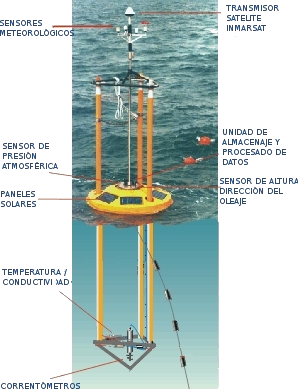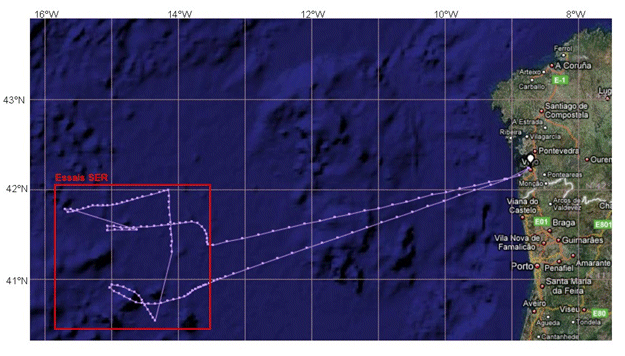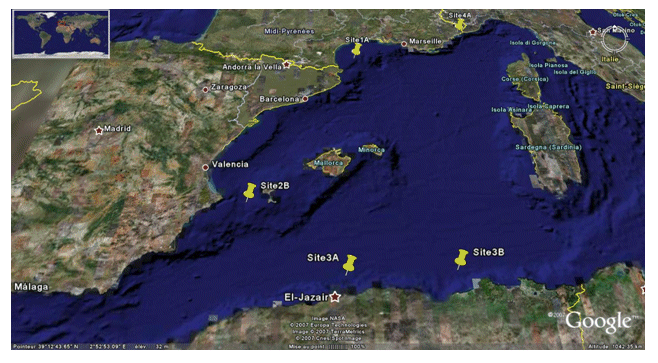Creation year
2007
191 record(s)
Type of resources
Categories
Topics
INSPIRE themes
Keywords
Contact for the resource
Provided by
Years
Formats
Status
Scale
-

Esta boya fue fondeada el 27 de Junio de 2007 a 22 millas al norte de Cabo Mayor (Santander) en la posición 43º 50.67' N, 03º 46.2' O y a una profundidad de 2850m.
-

Datos de temperatura y salinidad superficial registrados por el termosalinógrafo del B/O Naváz en la zona de la Ría de Baixas y plataforma continental adyacente.
-
Overall objectives in the EU GO project are to assess the promising potential of seismic imaging for physical oceanography, in view of its combination of fine resolution and coverage unmatched by conventional oceanographic measurements. D318 was to provide the means of assessment by obtaining a unique, comprehensive, oceanographic and seismic dataset at the same time and place. Specific objectives for R.R.S. Discovery cruise 318a were to deploy four ADCP moorings, three adjacent temperature-logger moorings and STABLE, in an L-shape array in 750-1000m depth east of Portimao Canyon, carrying out adjacent CTD stations, deploy two OBH moorings, carry out seismic sections using the Ifremer high-frequency air-guns and streamer, accompanied by regular XBT and less frequent XCTD casts. In addition underway data was logged including ship-borne ADCP, surface temperature and salinity, meteorology, gravity and magnetics (to test new NERC magnetometers).
-
The aims of this cruise were to elucidate the processes responsible for controlling iodocarbon concentrations and provide a dataset that can be used to develop modelled estimates of iodocarbon sea-air fluxes in tropical Atlantic waters.
-

Technological trials run on seismic equipment developed by the SERCEL firm.
-
The overall aim of the UKSOLAS project DOGEE-SOLAS is the parameterization of air-sea gas exchange, which is a currently a major uncertainty in global modelling. RRS Discovery cruise D320 thus was primarily concerned with the measurement of air-sea gas transfer velocities and some of the important physical parameters that influence them through contributing to near surface turbulence, and other processes. In brief, specific cruise objectives were: 1. Determine open ocean gas transfer velocities through a number of dual-tracer releases (3He & SF6). 2. Investigate the role of surfactant in gas exchange through a targeted surfactant release in conjunction with (1). 3. Determine CO2 fluxes and transfer velocities, and make associated hydrographic and turbulence related measurements from autonomous ASIS (Air-Sea Interaction Spar) buoys. 4. Measure air-sea fluxes of CO2, sensible heat, latent heat and momentum using the AUTOFLUX automated sensor array 5. Measure underway, total gas tension, dissolved O2, and CO2 to obtain independent air-sea gas exchange estimates. 6. Make covariance and gas budgeting estimates of air-sea gas exchange using intelligent profiling Lagrangian floats. 7. Independently determine DMS fluxes and gas transfer velocities for comparison with CO2 to examine the role of gas solubility in gas transfer. 8. Deploy a spar buoy (NOC) for measurement of wave heights and bubble properties 9. Record and measure whitecap coverage and wave breaking coincident with the air-sea flux measurements using ship mounted cameras 10. Record key meteorological variables 11. Quantify flow distortion biases in the direct flux measurements via the use of established models. 12. Make biogas, surfactant and bacterial measurements in the surface microlayer and in the uppermost metres of the ocean using surface microlayer samplers, a remotely operated catamaran, and a near surface sampler. 13. Deploy an autonomous powered profiler (ASIP) for turbulence-related measurements in the mixed layer. Objectives 1-12 were all met. Unfortunately, due to mechanical failure and loss of ASIP, objective 13 was not realised.
-
Overall objectives in the EU GO project are to assess the promising potential of seismic imaging for physical oceanography, in view of its combination of fine resolution and coverage unmatched by conventional oceanographic measurements. D318 was to provide the means of assessment by obtaining a unique comprehensive oceanographic and seismic dataset at the same time and place. Specific objectives for R.R.S. Discovery cruise 318b were to (i) recover four ADCP moorings, three adjacent temperature-logger moorings and STABLE, from 750-1000m depth east of Portimao Canyon (ii) perform deep water CTD casts (iii) carry out seismic sections using the NMF supplied Bolt airgun and streamer, accompanied by regular XBT and less frequent XCTD casts, iv) work with MV Poseidon to test novel seismic data acquistion strategies. In addition underway data was logged including ship-borne ADCP, surface temperature and salinity, meteorology, gravity and magnetics (to test new NERC magnetometers).
-
The objectives of the BELMER project are: - to validate the MERIS water products for Belgian coastal waters and neighbouring French, UK and Dutch waters - to provide a quantitative statement of product accuracy and recommendations for improvements in the scientific algorithms, where appropriate. In particular the problems reported by the MERIS validation and user communities of turbid water atmospheric correction, case 2 water chlorophyll retrieval, adjacency effects (straylight), moderate sunglint, spatio-temporal variability of specific inherent optical properties and bottom reflectance will be addressed. This project is funded by the "PROgramme for the Development of scientific Experiments" (PRODEX) of the European Space Agency (ESA).
-
Characterization of the Quaternary and Neogene sedimentary cover of the NW Atlantic shelf zone off Morocco and Quaternary deformations. This falls under the ANR ISIS project.
-

<p>The PRISME cruise objectives were to: - quantify the risk of earthquake-induced sedimentary liquefaction (for areas studied on the Algerian margin and slope off Nice, France); - quantify the risk of instability and failure due to loss of resistance in sensitive clay (slope off Nice); - quantify the risk of slope breaks and erosion caused by bottom currents (canyon heads - gulf of Lion); - identify the triggering factors for slides seen off Ibiza; - and begin to identify the turbidity related to seismic activity along the Algerian margin. This falls under the ANR-Isis an dGDR Marges projects. The cruise took place on 5 sites: Site 1A - Gulf of Lion - North: N 42° 50.00' South: N 42° 40.00' West: E 003° 35.00' East: E 004° 0.00' / Site 2B - Ibiza channel - North: N 38° 39.00' South: N 38° 37.50' West: E 000° 47.00' East: E 000° 51.00' / Site 3A - Alger - North: N 37° 30.00' South: N 36° 40.00' West: E 002° 00.00' East: E 004° 00.00' / Site 3B - Djijel North: N 37° 30.00' South: N 37° 00.00' West: E 005° 00.00' East: E 004° 00.00' / Site 4A - Djijel North: N 43° 40.00' South: N 43° 38.00' West: E 007° 12.00' East: E 007° 15.00'.</p>
 Catálogo de datos del IEO
Catálogo de datos del IEO